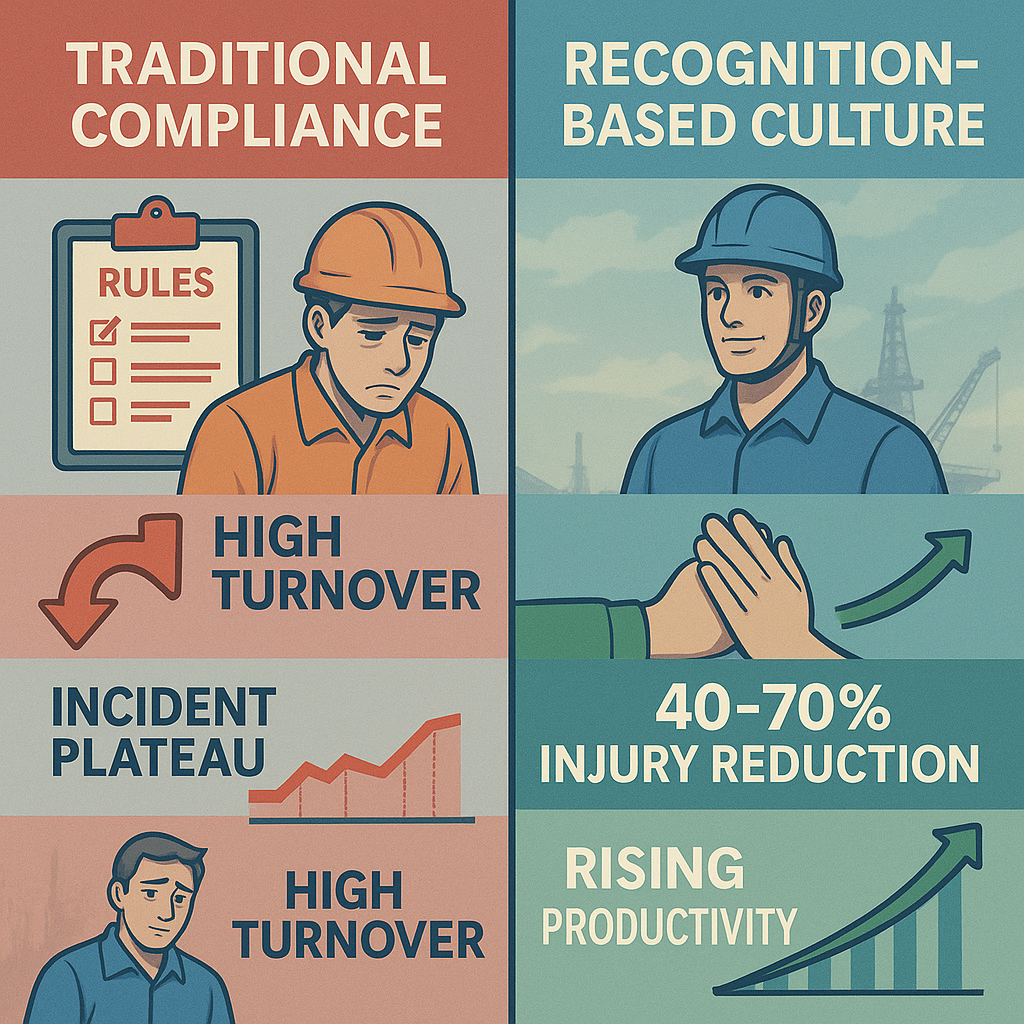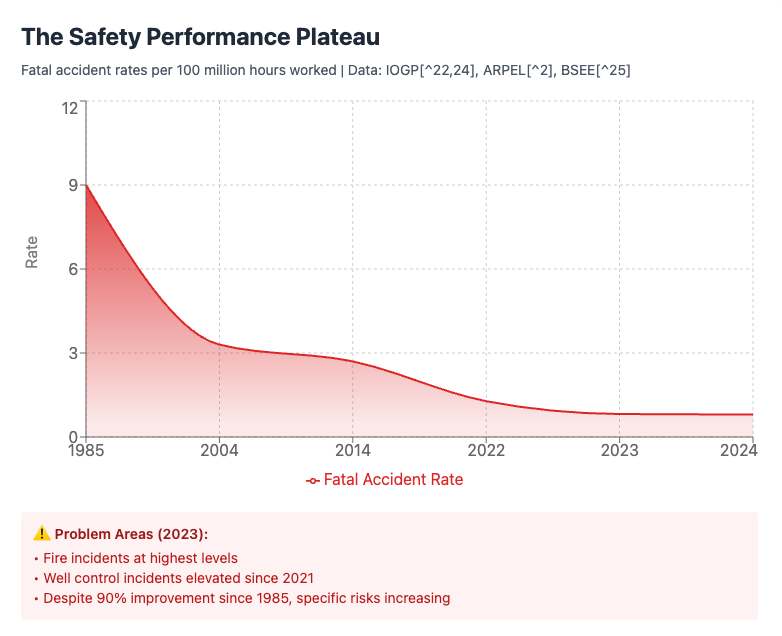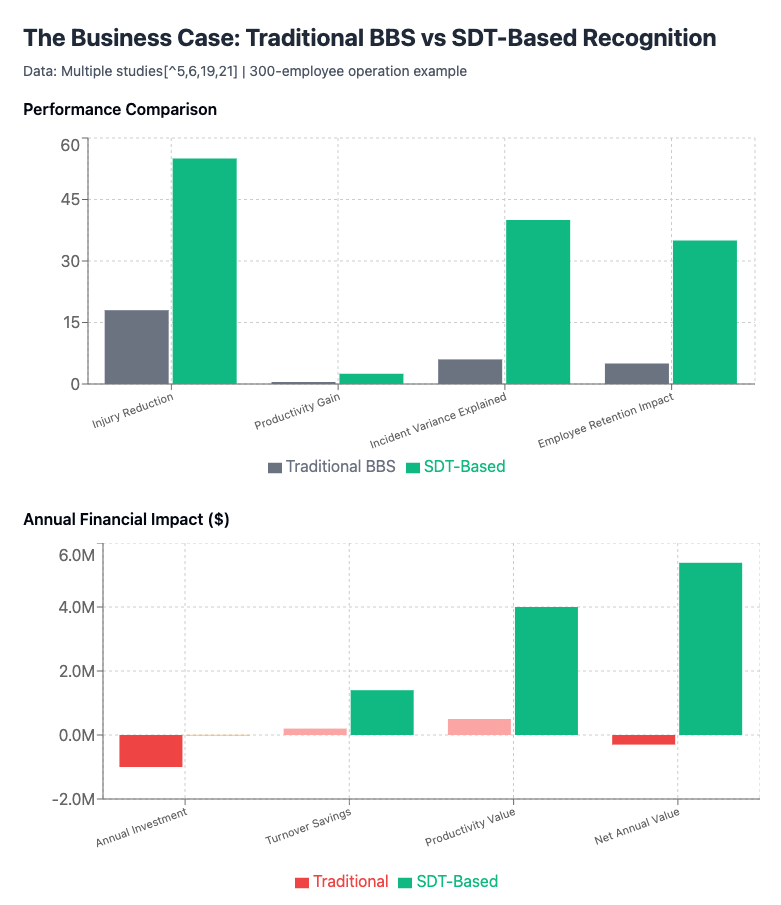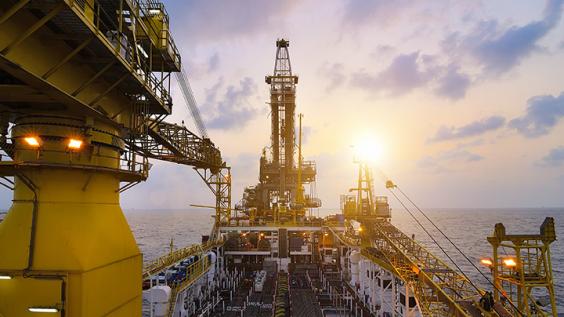The oil and gas industry has achieved remarkable safety improvements since the dark days of Piper Alpha. Fatal accident rates have decreased by more than 90% since 198522, and the industry's total recordable injury rate sits at just 0.81 per million hours worked24. Yet despite these gains, we've hit a plateau. Fire incident rates reached their highest levels in 202325, and well control incidents remain stubbornly elevated. After decades of refining procedures, implementing behaviour-based safety (BBS) programmes, and strengthening compliance frameworks, the question remains: what's the missing piece?
The answer lies not in more rules or stricter enforcement, but in understanding the fundamental psychology of why workers make the choices they do. Enter self-determination theory (SDT) – a scientifically validated framework that explains human motivation through three basic psychological needs. When applied to safety culture, it offers a path forward that traditional approaches have missed.
The Unique Psychology of Oil & Gas Workers
Consider the reality of offshore work. You're on a platform 100 miles from shore, working 12-hour shifts for two weeks straight. The work demands both strict adherence to procedures and the ability to make independent decisions when situations evolve. It's a paradox that defines the industry: we need workers who follow rules precisely, yet can think autonomously when those rules don't cover every scenario.

Research shows that 49.6% of offshore workers experience insomnia, 25.9% suffer from stress, and 30.5% experience depression10. The suicide rate among oil and gas workers is 54.2 per 100,000 – nearly double the average for working men3. These aren't just statistics; they represent a workforce under psychological pressure that traditional safety approaches fail to address.
The transitory nature of oil and gas workforces compounds the challenge. With annual turnover rates ranging from 9-11% for majors and up to 28% for FIFO operations6, maintaining consistent safety culture becomes increasingly difficult. Replacement costs for specialised employees can reach 400% of annual salary1, making retention not just a safety issue but a critical business imperative.
The Evolution of Oil & Gas Safety Culture

Generation 1: Post-Disaster Reactive (1988 Piper Alpha onwards)
Following Piper Alpha's 167 fatalities, the industry focused on hardware fixes and engineering controls. The Cullen Report's 106 recommendations revolutionised offshore safety regulation, establishing the safety case regime that required operators to demonstrate major accident hazard management7.
Generation 2: Systems and Standards (2000s)
The Texas City refinery explosion in 2005, which killed 15 people, exposed the dangerous fallacy of conflating personal safety metrics with process safety effectiveness3. Companies implemented ISO standards and Safety Management Systems, building extensive HSE departments and documentation requirements.
Generation 3: Behaviour-Based Safety (2010s)
After Deepwater Horizon's 11 fatalities in 2010, the industry recognised that technical compliance alone wasn't sufficient. BBS programmes emerged, focusing on systematic observation and feedback. Noble Corporation's digital BBS implementation achieved a 30% increase in safety reporting and saved an estimated $1 million annually1.
Yet BBS metrics explain only 3-9% of incident rate variance19, suggesting other factors play crucial roles. The continued reliance on Heinrich's accident pyramid theory – developed in the 1920s based on manufacturing insurance claims – may actually be holding us back. Modern research reveals that major process safety events often have different causal factors than personal safety incidents28.
Generation 4: Recognition-Based Culture (Now)
This is where self-determination theory changes the game. SDT identifies three fundamental psychological needs that drive human motivation15:
Autonomy: Workers need to feel they have control over their safety decisions. In an industry where "do this or you're toast" is commonplace, this represents a fundamental shift. When workers choose safe behaviours because they understand and value them – not because they're forced – compliance becomes sustainable.
Competence: Employees must feel capable and effective. Traditional safety culture only notices workers when they're incompetent – when something goes wrong. SDT-based approaches recognise and reinforce competence, creating positive feedback loops that strengthen safe behaviours.
Relatedness: Workers need connection with colleagues and belief that safety is a shared value. With mental health issues affecting 19% of oil and gas workers3, creating genuine connection isn't just nice to have – it's essential for operational safety.
Self-Determination Theory Meets Oil & Gas Reality
The application of SDT to oil and gas operations isn't theoretical. Research on oil and gas workers demonstrates that occupational health and safety management practices significantly influence both task performance and safety performance when mediated by work motivation2. When psychological needs are satisfied, workers exhibit higher levels of autonomous motivation, leading to measurably better safety outcomes15.

Consider how this works in practice:
Autonomy in High-Risk Environments: Pipeline operators face countless daily decisions about maintenance priorities, risk assessments, and resource allocation. Traditional command-and-control approaches say "follow the procedure exactly." But what happens when the procedure doesn't cover the specific situation? SDT-based approaches empower workers to stop work when conditions are unsafe, participate in safety planning, and contribute their expertise to continuous improvement. The result? Workers who own safety decisions rather than comply grudgingly.
Competence Recognition in Technical Roles: An experienced drilling supervisor has decades of pattern recognition that no procedure manual can capture. Traditional safety culture might give him an annual safety award – if he's lucky. SDT-based systems provide immediate recognition when that expertise prevents an incident, or even for simple safety hygiene. Research shows that when recognition happens at the moment of the positive behaviour, it creates dopamine and serotonin responses that reinforce the behaviour far more effectively than delayed rewards17.
Relatedness Across the Hierarchy: The disconnect between offshore workers and onshore management is legendary in our industry. Workers see "Zero Harm" posters and safety slogans as corporate lip service – messages that protect the company legally but don't reflect operational reality. SDT-based approaches use peer-to-peer recognition and team-based achievements to rebuild these connections. When a roughneck can recognise a colleague for good safety practice, and that recognition flows up to management, it bridges the divide that traditional top-down safety programmes create.
The Business Case for Oil & Gas
The numbers tell a compelling story. Companies implementing recognition-based safety programmes report:
- 40-70% reduction in workplace injuries when properly implemented6
- 2-3% productivity gains – significant in high-day-rate operations
- Reduced turnover in an industry where replacement costs can exceed $2.8 million for a 300-employee operation6
Beyond direct cost savings, SDT-based approaches address the looming workforce crisis. With 45% of the workforce over 50 and 550-650 workers expected to retire annually from Norway's offshore sector alone8, attracting and retaining younger workers is critical. Yet 62% of Gen Z and Millennials find oil and gas careers unappealing9. Recognition-based cultures that fulfil psychological needs can differentiate employers in this challenging recruitment environment.
Mental health costs alone justify the investment. Unmanaged mental health problems cost the oil and gas sector approximately $200 billion annually in lost productivity and skilled worker turnover3. SDT-based approaches address root causes rather than symptoms, creating work environments that support psychological wellbeing alongside physical safety.
Implementation Challenges in Oil & Gas
The Technology Challenge - Offshore platforms, refineries, and drilling sites often restrict personal devices. Modern SDT-based systems address this through pre-shift recognition activities, QR code systems for device-free environments, and integration with existing safety management platforms. The key is making recognition possible within operational constraints, not forcing operations to accommodate rigid systems.
The Culture Question - "We're roughnecks, not kindergarteners" – it's a sentiment heard across the industry. Yet the same roughneck who scoffs at recognition will buy a scratch lottery ticket on his days off. The psychology doesn't change with salary level. A $10 instant reward triggers the same neurological response whether you make $30,000 or $130,000. The difference is that in the workplace, that reward is tied to safe behaviour, creating positive reinforcement loops.
The Scale Challenge - From five-person wireline crews to 200-person offshore platforms, implementation must be scalable. Successful programmes start small – one crew, one platform – then expand based on demonstrated results. The key is maintaining consistency while allowing flexibility for local adaptation.
Starting Without Technology: Practical First Steps
You don't need sophisticated systems to begin applying SDT principles. Start with language. Instead of "You must wear PPE," try "Your expertise tells you when PPE is critical – thank you for modelling that for the crew." The shift from controlling to autonomy-supportive language costs nothing but changes everything.
In toolbox talks, recognise specific safe behaviours from the previous shift. Not generic "good job everyone," but "Yesterday, Tom stopped work to verify isolation before maintenance. That decision-making is what keeps us all going home safely."
Create peer recognition opportunities. A simple system where workers can acknowledge colleagues for safety contributions – even just verbal recognition in team meetings – begins building the relatedness that SDT identifies as crucial.
The Path Forward
The oil and gas industry has spent 30 years perfecting the "stick" – procedures, compliance, enforcement. These remain necessary but insufficient. The evidence from behavioural science, validated by oil and gas-specific research, points clearly toward adding the "carrot" – not as a soft alternative to compliance, but as the catalyst that makes compliance sustainable.
Companies already implementing SDT-based approaches through platforms designed for the industry report significant improvements across safety, productivity, and retention metrics. But even without formal systems, the principles can transform safety culture. When workers feel autonomous rather than controlled, competent rather than scrutinised, and connected rather than isolated, safety becomes something they choose rather than something imposed.
The industry that revolutionised safety management after Piper Alpha, that pioneered behaviour-based safety after Texas City, that advanced human factors understanding after Deepwater Horizon, now stands ready for the next evolution. Self-determination theory offers not just another safety programme, but a fundamental reframing of why people choose safe behaviours.
The question isn't whether to embrace positive psychology in safety culture – it's whether your organisation will lead this transformation or follow competitors who do.
Podcast
Hear Scratchie Co-Founder James Kell talk on The Crude Cast podcast about the Oil & Gas sector:










.svg)
